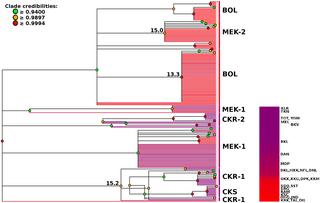PLOS Neglected Tropical Diseases ( IF 3.4 ) Pub Date : 2019-01-28 , DOI: 10.1371/journal.pntd.0007061 Stephen W. Attwood , Liang Liu , Guan-Nan Huo

|
Background
Neotricula aperta is the snail-intermediate host of the parasitic blood-fluke Schistosoma mekongi which causes Mekong schistosomiasis in Cambodia and the Lao PDR. Despite numerous phylogenetic studies only one DNA-sequence based population-genetic study of N. aperta had been published, and the origin, structure and persistence of N. aperta were poorly understood. Consequently, a phylogenetic and population genetic study was performed, with addition of new data to pre-existing DNA-sequences for N. aperta from remote and inaccessible habitats, including one new taxon from Laos and 505 bp of additional DNA-sequence for all sampled taxa,.
Principal findings
Spatial Principal Component Analysis revealed the presence of significant spatial-genetic clustering. Genetic-distance-based clustering indicated four populations with near perfect match to a priori defined ecogeographical regions. Spring-dwelling taxa were found to form an ecological isolate relative to other N. aperta. The poor dispersal capabilities suggested by spatial-genetic analyses were confirmed by Bayesian inference of migration rates. Population divergence time estimation implied a mid-Miocene colonisation of the present range, with immediate and rapid radiation in each ecogeographical region. Estimated effective population sizes were large (120–310 thousand).
Conclusions
The strong spatial-genetic structure confirmed the poor dispersal capabilities of N. aperta—suggesting human-mediated reintroduction of disease to controlled areas as the primary reason for control failure. The isolation of the spring-dwelling taxa and ecogeographical structure suggests adaptation of sub-populations to different habitats; the epidemiological significance of this needs investigation. The large effective population sizes indicate that the high population densities observed in surveyed habitats are also present in inaccessible areas; affording great potential for recrudescence driven by animal-reservoir transmission in remote streams. Mid-Miocene colonisation implies heterochronous evolution of these snails and associated schistosomes and suggests against coevolution of snail and parasite. Heterochronicity favours ecological factors as shapers of host-parasite specificity and greater potential for escape from schistosomiasis control through host-switching.
中文翻译:

湄公血吸虫(蜗牛)的中间居寄主-新小孔虫(Gastropoda:Pomatiopsidae)的种群遗传结构和地理变异
背景
细孔Neotricula aperta是湄公河血吸虫寄生虫的蜗牛中间宿主,它在柬埔寨和老挝人民民主共和国造成了湄公河血吸虫病。尽管进行了许多系统发育研究,但只有一项基于DNA序列的N的种群遗传学研究。aperta已出版,以及N的起源,结构和持久性。人们对Aperta知之甚少。因此,进行了系统发育和种群遗传研究,并为N的现有DNA序列添加了新数据。APERTA从远程和不可访问的生境,包括从一个老挝新分类单元以及用于所有采样类群505 bp的另外的DNA序列的,.
主要发现
空间主成分分析表明存在明显的空间遗传聚类。基于遗传距离的聚类表明四个种群与先验定义的生态地理区域几乎完全匹配。相对于其他氮,发现春季居住的生物分类群形成了生态隔离。阿佩尔塔(Aperta)。贝叶斯推断迁移率证实了空间遗传分析所表明的较差的分散能力。人口发散时间估算值暗示了当前范围的中新世中期定殖,每个生态地理区域都有立即和快速的辐射。估计的有效人口规模很大(120-31万)。
结论
强大的空间遗传结构证实了N的分散能力差。Aperta-建议将人为介导的疾病重新引入控制区域,这是控制失败的主要原因。春季居住的分类单元和生态地理结构的隔离表明,亚种群适应了不同的生境。这种流行病学意义需要进行调查。有效的人口规模很大,表明在无法到达的地区也存在在被调查的栖息地中观察到的高人口密度;在遥远的溪流中由动物-水库传播驱动的再生具有很大的潜力。中新世中期的殖民化意味着这些蜗牛和相关的血吸虫的异时进化,并建议反对蜗牛和寄生虫的共同进化。





















































 京公网安备 11010802027423号
京公网安备 11010802027423号